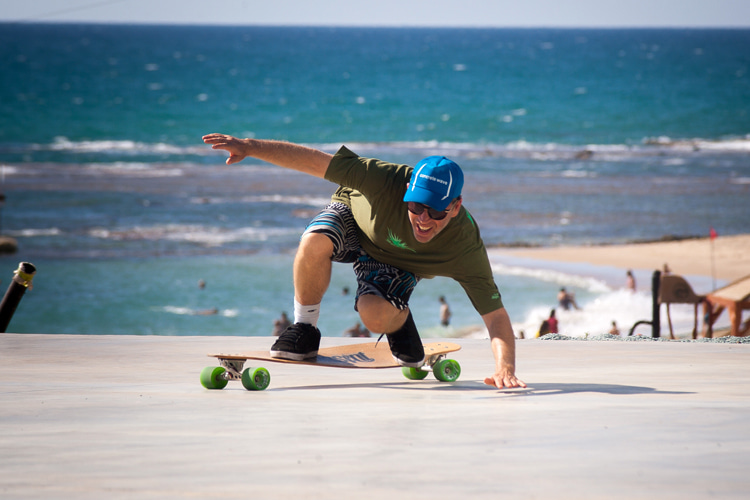Michael Brooke is an institution. His name echoes in the skateboarding world as one of its leading promoters and missionaries.
Brooke wrote one of the first books exclusively dedicated to the history of skateboarding and launched two legendary skate magazines.
Born in Leeds, England, in 1964, he was raised on punk rock before moving to London, Ontario, and later Toronto, Canada.
The publisher of Longboarder International and Concrete Wave was a pioneer in online skateboarding and rode the sport's several waves and eras.
The veteran longboarder worked with the largest surf-and-skate industry players and riders and helped build longboarding's reputation as a respected sidewalk surfing discipline.
Brooke's free and independent voice allowed him to make things happen, whether by trading guns for skateboards, building skateparks, or giving away boards to poor communities.
This man will ride a skateboard for life. And, sooner or later, he will be inducted into the Skateboarding Hall of Fame (SHoF).
In an exclusive interview with SurferToday.com, Michael Brooke reveals how a simple question changed his life.
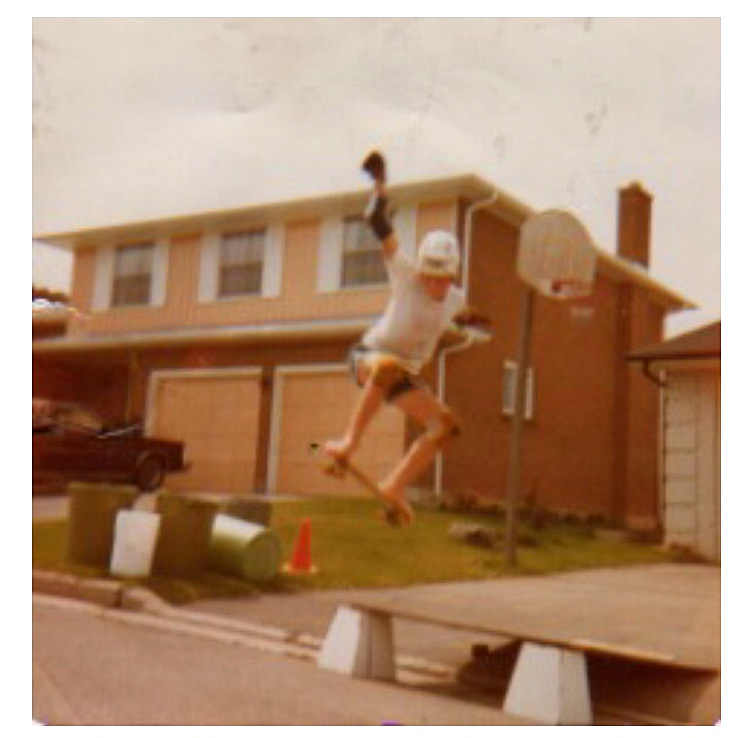
How, why, and where exactly did you try skateboarding for the first time in the summer of 1975?
I distinctly remember a kid in my neighborhood who had traded a knife for a beat-up skateboard.
I knew about skateboarding but had never tried it. So, I asked if I could jump on it to see what it was like.
I took one ride, and I was instantly hooked. I honestly felt I was going to fall, but somehow, I found my balance and have never looked back.
How would you describe the skateboard scene of the mid-1970s?
The scene was truly magical.
It was one of those things that, when I look back on it, it's hard to believe I was a part of it all.
Firstly, it was the second time around for skateboarding.
When skateboards first came out, they had either metal or clay composite wheels.
They were fun, but it was a really rough ride, and you'd hit a small pebble and... Wham! Down you'd go. The wheels didn't grip either.
Things changed with the introduction of the urethane wheel, and that's when skateboarding took off.
I happen to be at the tail end of the baby boomers.
This means that the front and middle boomers rode crappy products in the first wave and watched in horror as the sport died within three years or so.
I was fortunate to be born in 1964, which meant that I was the perfect age to get into skateboarding.
I was 11 when the second boom hit, and I had five solid years of watching the sport evolve with each passing issue of SkateBoarder Magazine.
The products got better, skateparks were everywhere, and the tricks were absolutely mind-blowing.
It is truly incredible to see how much progression was packed into such a short time.
The 1970s were an odd era for a lot of people. It was a time of excess and extravagance, and I was too young to be going into discos.
But, I am satisfied with the knowledge that I was in the right place at the right time for the second coming of skateboarding.
Was it a time of "changing of the guard" between riding styles?
Absolutely. Freestyle, downhill, and slalom started out as three key genres in the early 1970s, and by 1977, vert was dominating.
This was due to a number of factors.
The popularity of Dogtown skaters like Stacy Peralta, Jay Adams, and Tony Alva cannot be understated.
But riders like George Orton, Tom Inouye, and Steve Olson pushed things forward, too.
What were your favorite disciplines, and why have you focused on longboard skating?
The truth is I love riding everything, but my main focus for a number of years was freestyle skateboarding.
I didn't live near a great skatepark, and there were no backyard swimming pools to drain. So, as they say, geography is destiny.
I spent hours just practicing tricks in my parent's basement during the cold winter months.
I had a longboard skateboard back in the 1970s. It was fun to ride, but it wasn't too functional.
It had actually been produced in the 1960s and had clay wheels.
In 1988, I bought a Schmitt Six Yard Stix. It was a lot of fun and certainly generated a lot of looks.
But, it didn't have any flex and was really a 36'' pool deck.
In 1995, I was sent a fanzine called The Skate Trader, and this is where I discovered that longboards were available.
Something inside my brain just clicked, and I knew right there that I needed to pick one up.
I started calling local skate shops and found myself a 48'' Foundation Longboard.
A few months later, I picked up a Sector 9 Pintail and was hooked.
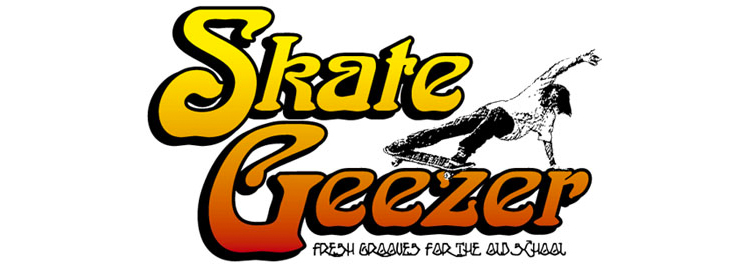
You had one of the world's first skateboarding websites - Skate Geezer Homepage. Do you remember how you set it up?
This came about due to a confluence of events.
In late 1994, I went to visit my parents - they lived two hours down the road.
My father was a professor at the University of Western Ontario, and he showed me this new thing on his computer.
He told me it was called "the internet."
He had a book - no search back then - that contained a number of subjects. I wondered if skateboarding was in there, and sure enough, it was.
So, I went to dansworld.com.
On this website, I discovered a whole bunch of information and immediately understood the power of the web.
I decided to write about my skate history.
Fortunately, Dan, the guy who ran the site, liked my submission and posted it online. After that, I started to get a ton of responses.
Then I realized I could make my own webpage filled with fellow skaters reminiscing on the past.
I asked my brother Andrew to put together the website.
He's always been good on the technical side of things. By 1996, the site was up, and I am proud to say that a quarter-century later, it's still there.
The original artwork for the website was done by Mike Moore. I think he did a beautiful job of capturing the old-school vibe of the site.
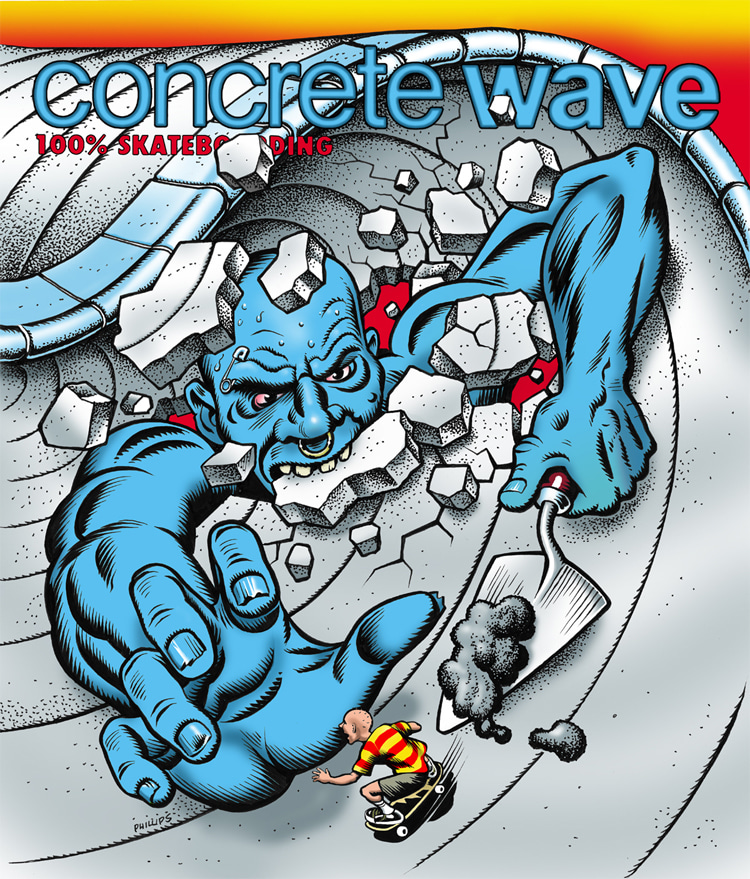
A meeting with Nick Pitt of Warwick Publishing in 1996 somehow changed your life for the next 20 years. How did you find information and contacts to gather the pieces of the puzzle and write "The Concrete Wave: The History of Skateboarding"?
I was trying to sell photocopiers and printers to book publishers and failing miserably.
For some unfathomable reason, Nick agreed to meet with me. As I explained Xerox technology, I could see his eyes glassing over.
But when I mentioned something about websites, he started to become interested.
I told him that I had a website, and he asked what it was about.
I told him "skateboarding," and that's when he said the sentence that would change my life.
"We're thinking about doing a book on skateboarding - why don't you put together a book outline?"
It was the catalyst that started me on an 18-month adventure to contact skate legends and big industry wigs.
I used the internet to contact dozens of people, and it was an unreal experience. I did this work while still holding down a full-time job.
In March 1999, "The Concrete Wave: The History of Skateboarding" book hit, and we wound up selling over 40,000 copies.
A best-seller in the United States is 10,000 copies.
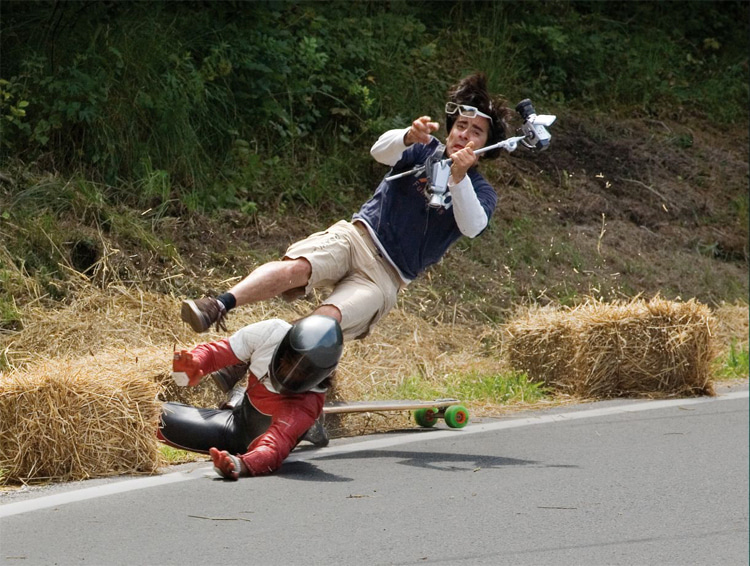
You lived through some of skateboarding's most defining eras. When did you feel it was a sport/outdoor activity that would impact the world, the people, and the cities we live in and ultimately create a whole new industry?
I witnessed skateboarding become popular, fade away, and then come roaring back. I've seen this cycle repeat itself a number of times.
I always knew that skateboarding was awesome. Even when I was the only skater in my neighborhood, I knew it was fantastic.
When I was one of the first longboarders here in Toronto, I knew its power to transform people.
I watched with a few billion folks the Olympic skateboarding events in July 2021. I was excited to see skateboarding hit this level, but at the same time, I was thinking like a skater.
This means I wanted more. I am glad skateboarding is included, but now it's time to think about having downhill and slalom.
Bringing in more disciplines would be great for both skaters and viewers.
The skate industry is powered by soft goods - shoes and clothing.
The companies that actually make and market boards, trucks, wheels, and accessories need as much support as they can get.
The truth is that for every $1 spent on skate hard goods, there's probably $10, or more, spent on shoes and shirts.
I haven't even factored in the energy drink and snack food companies who spend millions of dollars advertising to skaters and wannabe skaters.
So yes, it's a huge industry, but at the heart of it are the hard goods folks. I just wish sometimes people would put them first.
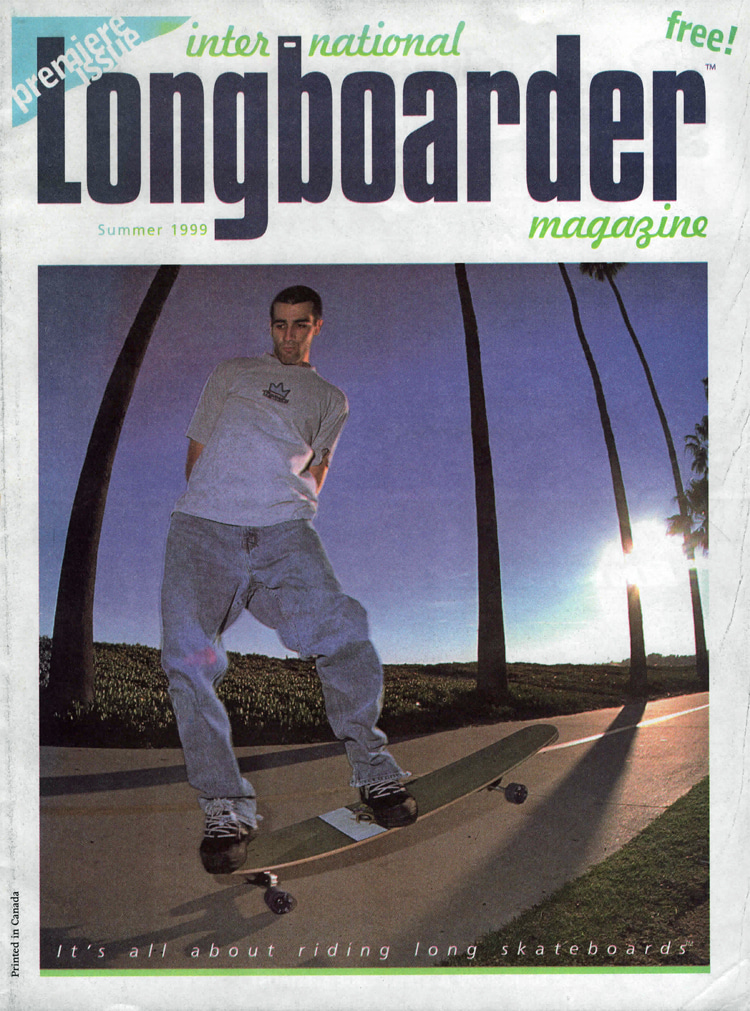
International Longboarder (1999) and Concrete Wave (2002) magazines are some of your most famous creations. How hard was it to bring them to life?
International Longboarder came about because I had finished the book, and I had nothing else happening.
It had been 18 months of researching and writing, and it all came to a stop. So, I thought, "What could I do next?"
Putting together a magazine was something I had never done before.
So, I contacted an old skate buddy who also happened to be a graphic designer.
His name was Tom Browne, and we started working on things in early 1999.
I spent a few hours calling various people I had met at trade shows and through my work with the book.
I raised about $5,000, and it was enough to launch.
The first issue was pretty rough, but it was the first time anyone had put ink to paper when it came to longboarding.
Concrete Wave was launched two decades ago within the pages of International Longboarder.
I did a test issue and, by June 2002, I had my first 32-page glossy edition. It wasn't too difficult to create Concrete Wave.
I could tell that there was a definite need to celebrate all types of skateboarding within print.
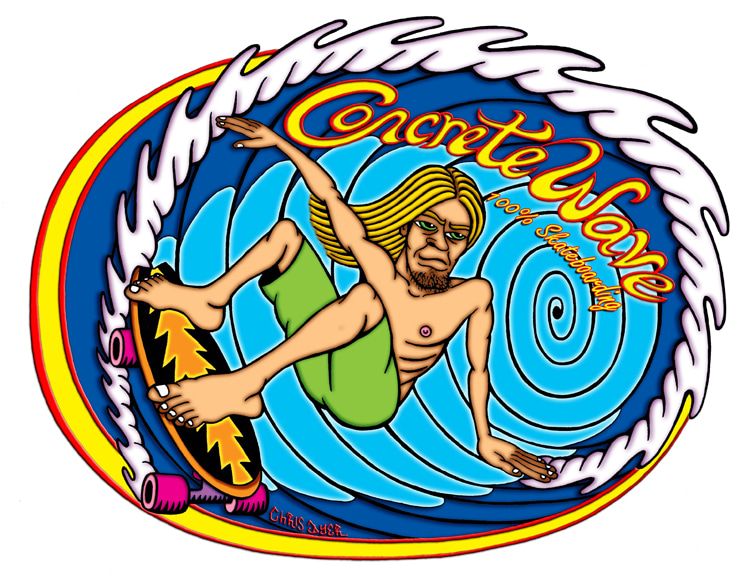
Longboarding has been skateboarding's poor child. Feel free to comment on the sentence.
Well, it might not have received the attention from the mainstream skate media that it warranted, but there was no doubting where the money was going and still goes.
The truth is that longboarding grew organically without the assistance of skateboard media.
The internet played a significant role in growing its popularity. Social media has done wonders for exposing longboarding to the world.
For a long time, I was the only person publishing stories about this part of the industry.
Even industry publications like Transworld Skateboarding Business didn't want to touch longboarding.
A lot of industry people thought longboarding wasn't cool enough. They were embarrassed by longboarding.
Many of these same people eventually wound up making a lot of money from longboarding.
How ironic is it that skateboarding, which projects a do-it-yourself, think-for-yourself, and question-everything mentality, got so close-minded when it came to longboarding?
Some in the skate world knew that longboarding was going to be big, and despite their best efforts to ignore it, it grew anyway.
Now, the genie is out of the bottle, and longboarding is just part of skateboarding, whether the street guys like it or not.
I always argued that the skate industry would be better served following the bike industry model.
You can buy a $75 bike at Walmart or $10,000 rims at the local bike shop. The choice is yours.
All the bike industry cares about is that you're enjoying yourself as a rider.
The same goes for Las Vegas. Sure, the nickel slots bring a different crowd than the high rollers playing backgammon.
But Las Vegas doesn't care - they just want you there enjoying yourself while you empty your hard-earned money into their hotel.
It's taken a long time, but I think that many skaters and industry folks have come to terms that diversity within skateboarding is here to stay.
You are now one of skateboarding's publishing legends and one of its finest historians. Do you still feel you've got more things to do in the sport?
That's kind of you to say. I am not a legend. I am just someone who loves skateboarding and writing.
I happened to be lucky enough to fuse these two elements together.
I think my latest contribution with Nathan Ho pretty much caps what I can do.
Our book "The Endless Wave: Skateboarding, Death, and Spirituality" was released as a free PDF in Fall 2021.
The feedback was good, and it's slowly percolating out there. I hope folks are inspired to download it.
I think it's my swan song - at least when it comes to writing about skateboarding.
I'd love to get a killer pump track built where I live in Canada. Unfortunately, raising money for things like this is not easy.
Your professional career has been a box full of surprises. You went from publishing to the funeral industry and still found a connection between death and sidewalk surfing. Allow us the cliché, but do you still believe skateboarding is for life?
It sure is for life.
I am more convinced than ever that skateboarding is one of the essential liquids you must add to drink from the fountain of youth.
Then again, being surrounded by so much death gives me quite an appreciation for life.
The truth is that as you get older, you may not be able to do all the moves you used to do.
But this doesn't matter - all that matters is you're still rolling. And yes, they're going to pry the skateboard from my cold, dead hands.
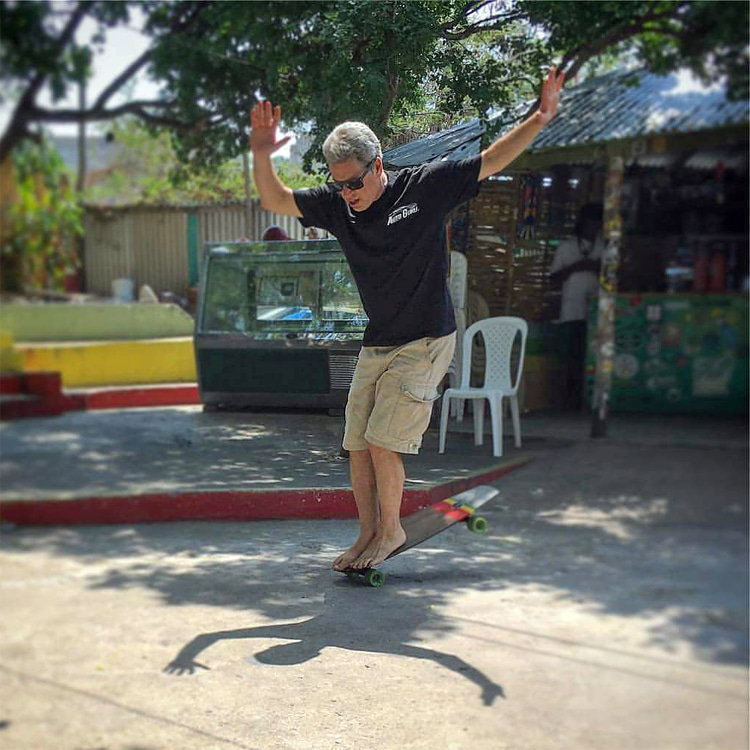
You worked in Longboarding for Peace. How does skateboarding make us better individuals?
I actually founded it ten years ago. It's kind of on hiatus, and I'd love someone to pick up the cause and run with it.
It was created because of the simple metaphor that riding a skateboard provides.
If you go too far to the right on a skateboard, you wind up in a circle. If you go too far to the left, the same thing happens.
The only way forward is to lean and turn both left and right.
If you look at the political climate in 2012, things were somewhat polarized. In 2022, things are at an unreal level, with extreme levels of hate and toxic rhetoric being spewed everywhere.
Skateboarding is about freedom.
It's about channeling energy. It's about forming friendships and relationships. It's about pushing and challenging yourself. It's about exploring and personal growth.
I could go on and on.
But if you look at the core of what it means to be a skater, you'll recognize what it means to be human.
And not just any human - a human with a joy for life who loves everything this magical board delivers.
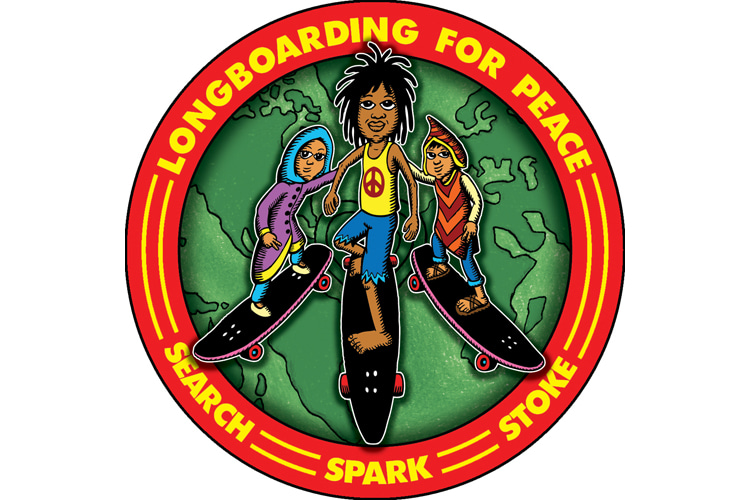
Could you name one thing that has been wrong in the skateboarding industry nearly almost since the sport picked up in the 1960s?
I think I might have touched upon this a few questions ago. The industry goes in cycles, and sometimes greed overtakes logic.
This is true in many industries but especially painful in skateboarding.
Skateboarding is too good to get overwhelmed by sharks, but sometimes it does.
Skateboarding has had more influence on surfing than the other way around. True or false? And why?
What a heavy question. That's a bit like asking, "Does hot water influence cold water?"
I view skateboarding and surfing as two pistons on a train - you need both for movement forward. They influence each other in so many great ways.
I don't live near the surf, and when I have an opportunity to be near it, I relish every moment. The vast majority of people are in my position.
If I can't be in the water, at least I can be riding concrete waves.
Do print skateboard magazines still make sense? Why?
I think people might gravitate to an annual magazine. Something that gives you the best of the year. It would be a nice memento.
As for actual mags, it's hard to move advertisers from the web to print. But an annual issue might work.
Are there more innovations that could be added to the skateboard as high-performance sports equipment?
I am not qualified to answer this question. But how about a beginner board that was crash-proof?
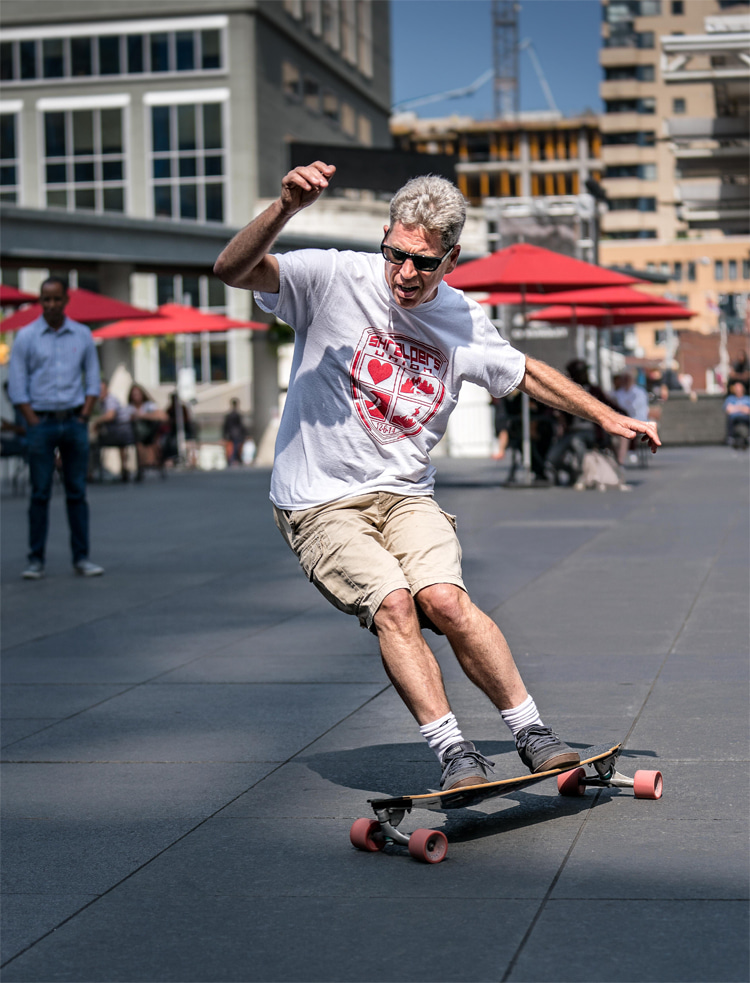
Do you still ride a skateboard? If so, which surprises and pleasures does it provide?
Of course. I will never stop riding. I still get excited when I visit a new skatepark.
As for pleasures - I just love the feeling of freedom and knowing I am keeping my body and mind in balance.
How do reading books, news articles, and features make us better skaters?
They connect us as skaters. They make us feel part of a community.
There will always be people who want to build a scene within skateboarding. They will want to host events and spread the stoke.
Some will want to create their own companies; some will infuse their creative skills and create impressive videos or art.
Documenting all those who ride, create, build, and put their heart and soul into skateboarding is something that is truly important.
Skateboarding is an amazing vessel for the passion we feel for life.
And sometimes, when this passion starts to evaporate, it is the best way to refuel the tank.
This is why I love skateboarding, and if you've read this far, I am pretty sure you feel the same way I do.
